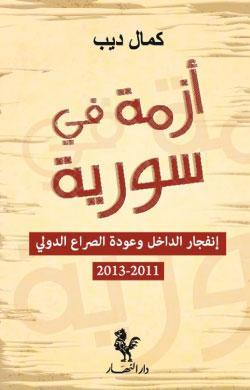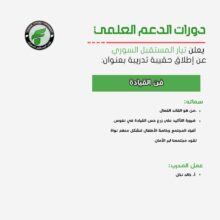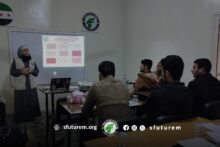Reading in a Book: “Crisis in Syria: The Explosion Within and the Return of International Conflict 2011-2013”

“Crisis in Syria: The Explosion Within and the Return of International Conflict” by Dr. Kamal Deeb, a Canadian author and historian of Lebanese origin, who holds a PhD in Economics. The book, published by Dar Al-Nahar in 2013, Beirut, aims to acquaint primarily Lebanese and secondarily Syrians with the history of Syria, in an effort to dispel the prejudiced and racist judgments that have tainted the atmosphere of Syrian-Lebanese relations, according to his vision, to penetrate the “popular conscience.”
Deeb, who previously released “The Contemporary History of Syria” before the Syrian revolution, maintains a negative stance towards the Arab Spring. However, fairness dictates that his work be described as an encyclopedic endeavor, which he completed with our current read.
The book spans 332 pages of medium size and contains information about that era of our revolution unknown to many Syrians themselves. Deeb begins his work with a text by Gibran Khalil Gibran from “The Tempests” followed by a poem by the poet Said Akl about Damascus, and after conveying thanks for his previous book, “The Contemporary History of Syria,” there’s an introduction by the former Lebanese minister and former head of the Lebanese Kataeb Party, Mr. Karim Pakradouni, titled “Syria in the Eye of the Storm.”
Deeb reveals that the Syrian war has seven “doors,” corresponding to the seven historical gates of Damascus mentioned in his introduction.
In the first section, he discusses the Syrian crisis in the media and diplomatic war, highlighting America’s attempts since the 1950s to take over Syria, which have failed. The threats by Colin Powell to Bashar al-Assad in May 2003 resonate in the spring of 2011.
The second section considers Syria as part of the Arab Spring.
The third section discusses the conflict between the Ba’ath and the Muslim Brotherhood, considering it the primary carrier of the Syrian revolution, and the underlying conflict between the Alawite minority and the Sunni majority, based on the demonstrations emerging from border areas with a Sunni complexion. Deeb warns that a victory for the revolution in 2011 would mean a victory for the Muslim Brotherhood, turning Syria into a Taliban-like Afghan model.
In the fourth, he talks about undermining religious and ethnic pluralism, where Assad’s Syria was a manifestation of the Alawites emerging from their shell to engage in power, the rise of a new Sunni bourgeois class, and the participation of minorities in politics and economics. This slowed the reform process to prevent Syria from turning into a fragmented Lebanese example, concluding that the Syrian people were not ready for political reform.
The fifth discusses the exacerbation of the Syrian situation through an internal social explosion, economic globalization, and the disparity between population growth and economic growth leading to high unemployment and severe poverty levels in the 1990s. Deeb blames the Syrian regime for not holding the corrupt accountable and describes it as economically ignorant of the private sector’s movements.
In the sixth, he talks about the failure of the Damascus Spring.
The seventh mentions that the Syrian crisis is part of its conflict with Israel, asserting that targeting the Syrian regime was due to its opposition to the Zionist project, indirectly supporting the rebels and managing battles behind the scenes, along with logistical and media support for the Syrian revolution after 2011.
In his book’s conclusion, titled “Summary and Crossroads,” Deeb exhibits an obsession with conspiracy theories, attributing the events in Syria after 2011 to American will and Israeli hands, while neglecting the internal causes that expanded and militarized the Syrian revolution. Despite his negative stance towards the Syrian revolution, considering it a manifestation of a conspiracy against the Syrian state rather than the regime, he does not exonerate the Syrian regime from tyranny, nor deny the existence of Syrian opposition or revolutionaries fighting tyranny only, not executing foreign agendas. Israel felt secure during the Ba’ath and Assad’s rule, and the American stance towards the Syrian regime has been non-hostile, especially evident in withholding anti-aircraft weapons from the Syrian opposition at the height of Western support.
Deeb criticizes the Syrian opposition’s ignorance of proper conflict tools, stooping to the regime’s sectarian level, losing social blocks for free. Despite the emergence of radical groups, the opposition initially called for “no to sectarianism.” This highlights the need for non-neutral, objective historians inclined towards truth and the Syrian people to document the Syrian revolution, step by step, year by year, through writing, as books remain a legacy for generations, unlike solely relying on documented history by activists today.
Kamal Deeb, in one way or another, managed to strip the Syrian revolution of its moral legitimacy, despite acknowledging the existence of tyranny within the Syrian regime. This makes it imperative for his book to receive objective criticism from Syrian historians, which is perhaps why we chose the title for this book.
Elias Abdel Maseeh






